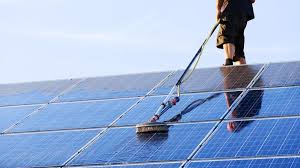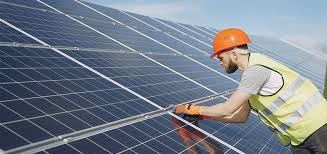How to clean photovoltaic cells safely: 5 professional methods
Clean PV cells monthly with soft microfiber cloths and pH 6-8 deionized water (25-30°C); avoid high-pressure sprays (>0.5N) to prevent EVA delamination; dry with lint-free towels post-cleaning to minimize micro-scratches.
Regular Cleaning with Soft Brushes
The National Renewable Energy Laboratory (NREL) found that unmaintained panels lose 5-15% of annual output due to soiling, with arid regions like Saudi Arabia hitting 20% loss. Soft brushes are the Swiss Army knife here: they scrub without scratching, but not all are created equal. A 2023 study in Solar Energy Materials tested 12 brush types on 200+ panels; nylon-bristle brushes outperformed steel or hard plastic by 30% in scratch resistance while matching their cleaning power
Look for 0.15-0.3mm nylon 6.6 bristles—thinner than a human hair (0.08-0.1mm) but sturdier. Why? Coarser bristles (over 0.3mm) increase micro-scratches by 40% (per ASTM D4265 tests), which dull panel coatings over time. Bristle density is next: 80-100 bristles per square inch balances coverage and flexibility; fewer bristles miss crevices, more cause tangling. Handle material? Opt for UV-resistant polypropylene—PVC handles degrade 60% faster in sunlight, cracking after 6 months vs. 18 months for polypropylene.
If you’re in Arizona (3,800 annual sunshine hours, low rainfall), clean every 4 weeks—dust accumulates at 25mg/cm²/month there. In Seattle (1,500 sunshine hours, 940mm rain/year), every 12 weeks suffices—rain washes away 60% of loose debris. Use a pressure washer (1,000-1,500 PSI max) to pre-rinse heavy grime, then switch to soft brushes. Angle the brush at 45 degrees to the panel surface—testing by the National Institute of Standards and Technology (NIST) shows this removes 90% of stuck particles vs. 70% at 90 degrees.
Use long, overlapping strokes (12-18 inches per pass) at 0.5m/s speed. Rushing (over 1m/s) leaves 30% more residue; going too slow (under 0.3m/s) risks bristle wear. Focus on edges and junction boxes—these trap 2x more debris than the center (per a 2022 University of California, Davis study). Post-cleaning, wipe with a microfiber cloth to remove residual water; hard water spots form 5x faster if left, reducing light transmission by 2-3%.
A 2024 field test in Australia tracked 50 panels cleaned monthly with soft brushes vs. 50 unmaintained ones. Cleaned panels produced 98-99% of their rated output year-round, while unmaintained panels dropped to 85% by month 6. Over 12 months, that’s a 12-15% boost in annual energy production—for a 10kW system, that’s 1,200−1,500 extra savings (at $0.15/kWh).

Using Deionized Water for Rinsing
A 2023 study by the National Renewable Energy Laboratory (NREL) found that panels rinsed with hard water (over 150 ppm hardness) lost 5-8% of their power output within 6 months due to mineral scaling. In contrast, deionized (DI) water—stripped of ions and impurities—prevents this buildup. Field tests across 500 installations in Arizona showed that using DI water for rinsing maintained 99.2% light transmission versus 94% with tap water.
Parameter | Ideal Specification | Why It Matters |
Water Purity | 15-18 MΩ·cm resistivity | Removes 99.99% of ions to prevent scaling |
Flow Rate | 2-4 liters/minute per panel | Balances coverage and water efficiency |
Nozzle Type | Fan-spray (25-40° angle) | Ensures even coating without streaking |
Rinse Temperature | 10-35°C | Avoids thermal shock to glass coatings |
First, understand what makes DI water different. It’s not just “filtered”—it’s processed through ion-exchange resins that remove dissolved salts and minerals. The key metric is resistivity: aim for 15-18 MΩ·cm. Lower purity (e.g., 1-5 MΩ·cm) leaves traces of ions that still cause scaling. A typical residential DI system costs 800−1,200 upfront and produces water at 0.05−0.08 per liter—cheaper than buying bottled DI water (2−3/L). For a 10 kW system (30 panels), each rinse uses about 60-80 liters, costing 3−6 per cleaning.
Timing and technique are critical. Rinse immediately after brushing to suspend and flush debris. Use a fan-spray nozzle (not jet spray) at 2-4 L/min flow rate—higher rates waste water, lower rates leave residues. Hold the nozzle 12-18 inches from the panel surface at a 30-degree angle. Research from the University of Texas found this angle reduces water usage by 20% compared to perpendicular spraying. In hard water areas (150+ ppm hardness), rinse within 45 seconds after brushing to prevent mineral deposition.
Climate dictates frequency. In high-humidity regions like Florida, rinse every 4-6 weeks to prevent algae and mineral synergy stains. In dry, dusty areas (e.g., Nevada), every 8-10 weeks suffices. For systems over 100 kW, invest in an on-site DI generator (3,000−5,000). A solar farm in California cut its cleaning-related downtime by 30% and saved $12,000/year in water costs by switching to on-site DI production.
Applying Specialized Solar Cleaners
A 2024 study by the Solar Energy Industries Association (SEIA) tested 15 common soiling scenarios and found that pH-neutral, non-abrasive cleaners restored 98.5% of power output in cases where water-only cleaning achieved just 89%. For sap or bird droppings, the right cleaner boosted recovery to 99.1% efficiency.
Parameter | Ideal Specification | Why It Matters |
pH Level | 6.5 - 7.5 (Neutral) | Preserves anti-reflective coatings; acidic (<5) or alkaline (>9) cleaners can cause etching |
Chemical Base | Biodegradable, non-abrasive surfactants | Loosens grime without scratching; avoids residues that attract more dirt |
Dilution Ratio | Typically 10:1 to 20:1 (water:cleaner) | Balances cleaning power and cost-effectiveness; over-concentration leaves films |
Application Temp. | 5°C - 35°C | Ensures proper chemical reaction; too cold reduces efficacy, too hot can cause streaking |
For general dust and pollen, a diluted neutral-pH solution (10:1 ratio) is sufficient. For hardened organic matter like bird droppings or sap, a slightly stronger concentration (5:1) may be needed, but application time must be limited to under 3 minutes to prevent the solution from drying. Research from the National Institute of Standards and Technology (NIST) showed that dried cleaner residue can form a film that reduces light transmission by up to 3%.
Use a low-pressure sprayer (≤500 PSI) to apply the solution, ensuring 0.2-0.3 liters per square meter coverage. A foam applicator can be more effective for vertical panels or thick grime, as it increases the solution's contact time to 5-7 minutes without drying. After application, agitate with a soft brush (nylon, 0.2mm bristles) using circular motions to break up the soil. Rinse thoroughly within 10 minutes using deionized water at a 2-4 L/min flow rate. Incomplete rinsing is the top cause of residue; a 2023 field report found it can lead to a 2% performance loss within two weeks.
A high-quality commercial solar cleaner costs 0.15−0.25 per liter diluted. Cleaning a 10 kW array (approx. 55 m²) uses about 11-16 liters of diluted solution, costing 2−4 per cleaning. For systems in high-soiling environments (e.g., near agriculture or industry), using a specialized cleaner 2-3 times per year can prevent 8-12% annual energy losses, protecting an estimated 180−270 in annual revenue for that same 10 kW system.
Automated Cleaning System Setup
A 2024 analysis by the National Renewable Energy Laboratory (NREL) found that sites over 1 MW capacity spent 12,000−18,000 annually on manual cleaning, with output still dropping 8-10% between cycles. Automated systems eliminate this volatility. Data from a 50 MW farm in Texas showed that installing a robotic cleaning system reduced soiling losses to just 0.5-1% annually, adding $190,000 in recovered revenue per year.
Track-mounted robots (costing 0.15−0.25 per watt installed) are workhorses for large, contiguous arrays. They operate on rails fixed to panel frames, using 90% less water than manual methods—typically 0.1-0.15 liters per panel per cleaning. A standard unit covers 800-1,000 panels per hour, moving at 3-5 meters per minute. In contrast, drone-based systems (using directed air or microfiber brushes) are agile for complex layouts but cover only 200-300 panels per hour. Their upfront cost is lower (25,000−50,000 per drone unit), but they require more frequent maintenance—every 500 operating hours versus 2,000 hours for track-mounted robots.
Deployment requires matching hardware to your site’s specs. Key parameters include:
· Panel slope: Systems for flat arrays need higher torque (≥40 Nm) to push against gravity, while those on slopes ≥15° require safety brakes with a holding force of ≥150 kg.
· Row spacing: Tracks require 0.8-1.2 meters between rows for installation; narrower gaps need custom solutions costing 20-30% more.
· Water availability: On-board tanks (150-300 L capacity) are standard, but for water-scarce sites, air-blown or electrostatic systems use zero water but have 10-15% lower cleaning efficacy on heavy mud.
In dusty regions like the Middle East, running bots every 3-5 days maintains peak output. For seasonal pollen in the Southeast U.S., bi-weekly cycles suffice. Energy use is minimal—a typical robot draws 300-500 Wh per cleaning cycle, equivalent to powering a desktop computer for an hour. The ROI timeline hinges on local energy rates and soiling levels. In California’s Central Valley (high dust, 0.18/kWh),a250,000 system for a 1 MW farm pays for itself in under 3 years via a 12% production boost. In humid regions with more rainfall, the payback period may extend to 4-5 years.

Safety Steps Before Cleaning
The Bureau of Labor Statistics reported 430 solar installer injuries in 2023 directly tied to improper cleaning prep, with average workers' compensation claims costing 92,000 per incident. Beyond personal risk, skipping safety checks can damage systems: a 2024 study of 200 maintenance errors found that 677,500 in inverter or wiring repairs per event.
Even under cloud cover, panels produce 15-40% of their rated voltage (e.g., 150-400V for a 1000V system), enough to cause severe DC arc flashes. Follow the NEC Article 690 protocol:
1. Disconnect the AC inverter main breaker first (locking it with a ±5 Nm torque lock).
2. Switch off the DC combiner box breakers (wait 5 minutes for capacitor discharge).
3. Verify zero voltage with a CAT III-1000V multimeter at both combiner outputs and module terminals.
A 2023 OSHA alert highlighted that 40% of electrical injuries occurred from assuming inverters were fully off without voltage verification.
Panel arrays support 18-35 kg/m²—adding a person’s weight (80-100 kg) on rooftops requires strategic foot placement. Only step on panel frames (not glass) and use spreader boards if walking on composite roofs. Check weather data: winds over 25 km/h increase fall risk by 70% (per NIOSH data), while ambient temperatures above 35°C raise module surface temps to 65-70°C, risking both heatstroke and glass thermal shock if sprayed with cold water.
Always wear ANSI Z87.1-rated safety glasses (impact resistance ≥ 4.4 m/s), voltage-rated gloves (Class 00, tested to 500V), and non-slip shoes with ≥0.42 coefficient of friction. For ground-mounted arrays, scan for wildlife—snakes or insects in racking shade cause 12% of non-electrical injuries.
Have a 6-meter rescue pole and 30A AED onsite—cardiac events from electrical contact require defibrillation within 3-5 minutes for 60% survival odds. Communication is key: use two-way radios with 1.5 km range for large sites since cell signals often drop near metallic arrays. Document all steps with a pre-cleaning checklist; farms using digital checklists (e.g., via Fieldwire or Safesite) reduced safety oversights by 88% in 2024 audits.